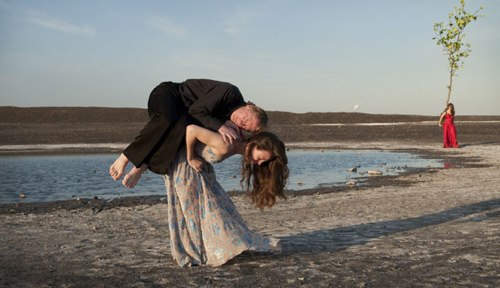Berlinale Dispatch: Wim Wenders Takes His Place in the 3-D Vanguard
Seeing two 3-D movies in a row is pretty much my idea of torture, and a colleague and I came very close to decamping to see The Touch (with my beloved Elliot Gould), which is being shown as part of the festival's Ingmar Bergman retrospective. In the end, persuaded by a few enthusiastic colleagues, we -- with much eye-rolling and many deprecating remarks -- opted to check out Wim Wenders' Pina. I'm glad we did.
For years, Wenders and German modern-dance choreographer Pina Bausch, longtime friends, had been working on a movie together. Bausch died suddenly in 2009, at age 68, and this is Wenders' tribute to her, less a strict documentary than a heartfelt -- and visually gorgeous -- celebration of Bausch's work and her mode of working.
I'd always avoided Bausch, assuming it was all bony dancers in drab skintone leotards, miserably acting out the angst of mankind, or whatever. I now know how wrong I was. Some of Bausch's ideas may not result in anyone's idea of conventional (whatever that is) beauty: She might scatter the floor with peat moss, which would mingle with the sweat clinging to the dancers' dresses, resulting in damp, mother-earth stains; a man in a tutu, being pushed along slowly on a railway handcar, appears to be carrying some pretty heavy-duty German sorrow and guilt on his shoulders.
But Wenders makes it all seem accessible, framing and connecting images -- sometimes very strange ones -- in a way that draws us closer rather than alienating us, without ever softening the intended effect. He films a dancer in a printed chiffon dress pirouetting en pointe against a drab, deserted industrial backdrop. Did I mention that there's uncooked veal squidging from her slippers? Wenders hardly pretends this is business as usual. Rather, he coaxes us into understanding, or at least reckoning, with the jarring but wholly compelling image in front of us. It's as if he were saying, "I realize this woman has stuffed raw meat in her toe shoes, but trust me, go with it."
And if you're going to film anything in 3-D, why not dancers? Wenders revels in the contours and angles of these glorious bodies, some of which are brazenly muscular in some places and fleshy in others. (Bausch used dancers of all ages.) There's vast grace and beauty here, but there's also evidence of how dancers put their bodies to work: Jutting shoulderblades, veins a-poppin', bunions coming right at ya! Wenders' camera shows it all. I don't want to see older films retrofit in 3-D, God forbid. But watching Pina made me wonder what Claire Denis Beau Travail -- an openly passionate ode to the male human body -- would look like if it had been made in 3-D.
There's a third 3-D picture here at the festival, being shown out of competition: Werner Herzog's lyrical, vaguely spooky Cave of Forgotten Dreams, in which our happy-go-lucky guide and narrator reveals the splendor of ancient wall drawings in the Chauvet caves of France. I saw Cave in Toronto last September -- you can read about it here -- but its charms haven't dimmed for me since then. While I still think 3-D should be used sparingly (even under the best circumstances, it makes the old eyeballs work overtime), it's heartening to see filmmakers having so much fun with the medium, and with the aim of pleasing their audience -- not fleecing them.
Pages: 1 2


Comments
Your friend Laura Miller (kinda) wrote recently that precise prose and careful delineations are also tiring to the eyes and mind -- slows down reading speed, sometimes to a crawl, when you know you've got a whole book ahead: I'm wondering if some people have to prepare for your reviews akin to how you did this double-feature: in this case, a bit of "Oh God! Another load of particulars and careful delineations about some film I haven't any sense of!," to gird for themselves some countering camaraderie within the melee of stimulation they may soon be treated to? I'll wait 'til I've seen what you've seen to make reading your review more an immediate experience of compare and contrast -- "look, sister, I take your point, but this is what you didn't see ..." For now it's the reality-possibilities ... like is it true that what is jarring can also be compelling? You seem sure of it, for how else last time would "the land look menacing and alluring at once." Mind you, "menacing" already has something of the alluring within it -- you're wanted-enough to be wholly devoured; "compelling" here is a smart wink, and a hinted-at better path ahead, after having had a door slammed in your face: it's harder to see how you'd ever after let yourself just be drawn along, when all the time you're surely mostly thinking how you can knife the f*cker back in return.